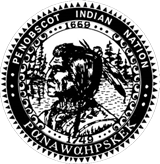Tribal Timeline
12,000 to 9,500 BP (Before Present) – Paleo-Indian Period
9,500 to 3,000 BP – Archaic Period
3,000 to 500 BP – Ceramic Period
1524 – Giovanni da Verrazano is credited with the first ‘documented’ contact with Native American in Maine.
1525 – Estevan Gomez (ca. 1483-1538), Portuguese exploring for Spain, sails up Penobscot River to site of present–day Bangor
1568 – David Ingram is credited with the first documentation of a Penobscot Chief, Bessabez
1604 to 1605 – Samuel de Champlain cartographer sailing for France charts the Maine coast; Sieur de Monts, a French Nobleman, tries to establish permanent settlement on St. Croix Island.
1605 – Port Royal is the first permanent European settlement in North America north of Florida, having been founded by Pierre Dugua, Sieur de Monts and Samuel de Champlain.
1605 – George Weymouth, sailing for England, captures and kidnaps five Penobscot Men.
1607 – George Popham and Raleigh Gilbert, along with the captured Indians from Weymouth, establish English settlement, Fort Saint George (the Popham Colony), at the mouth of the Kennebec River, this settlement failed.
1611 – Father Pierre Baird, a French Jesuit, establishes Indian mission at Indian Island on Penobscot River.
1607 to 1615 – Micmac Wars (aka Tarratine Wars)
1615 – Death of Bessabez
1616 to 1619 – The “Great Dying,” 75 to 90 percent of Native Americans die from European diseases.
1635 – French establishes Fort Pentagoet on the eastern shore of Penobscot Bay.
1638 to 1655 – Beaver Wars, conflicts with the Mohawks over territory during the Fur Trade
1670 – Jean Vincent de Abbadie, the Baron of Castin arrives in Maine.
1675 to 1678 – King Philips’ war breaks out in Massachusetts by Wampanoag leader Metacom.
1688 to 1699 – King William’s War
1703 to 1713 – Queen Anne’s War, bounties offered for Native American scalps.
1721 to 1726 – Dummer’s War (aka Lovewell’s War)
1724 – Massacre at Norridgewock. English sack and burn Indian village on the Kennebec, Fr. Sebastian Ralse is killed in attack.
1725 to 1726 – Indians and settlers reach accord in Dummer’s Treaty, ending Dummer’s War.
1744 – King George’s War begins.
1754 – French and Indian War begins.
1755 – Scalp Proclamation issued by Massachusetts Bay Colony
1775 – Penobscot Chief Joseph Orono with a Penobscot Delegation pledge alliance with Americans in Watertown, Massachusetts
1790 – Trade and Non-intercourse Act passed by United States Congress to protect Indian land transfers
1796 – Treaty between Massachusetts and Penobscot.
1818 – Treaty between Massachusetts and Penobscot which established reservation lands.
1820 – Maine becomes a state as part of the Missouri Compromise.
1820 – John Neptune guides Joseph Treat as he surveys the Penobscot, Allagash and St John Rivers.
1833 – Four Penobscot Townships are “sold” by the State of Maine.
1846 – Writer and transcendentalist Henry David Thoreau visits Indian Island for the first time.
1853 – Henry David Thoreau hired Joseph Attean as a guide.
1857 – Henry David Thoreau hired Joe Polis as a guide.
1870 – Joseph Attean dies on the Fourth of July at Grand Pitch Falls near Millinocket, Maine.
1893 – Joseph Nicolar publishes Life and Traditions of the Red Man.
1897 – Louis Sockalexis, a Penobscot Indian born on Indian Island, becomes the first American Indian to play for a Major League baseball team, the Cleveland Spiders (later the Cleveland Indians).
1880’s to 1917 – Penobscot children are sent to Federally sponsored Residential Schools.
1912 – Andrew Sockalexis runs in the Olympics in Stockholm, Sweden. He finished fourth.
1924 – Native Americans are designated as citizen of the United States.
1946 – State of Maine issues Proctor Report, outlining State of Maine and Indian relations.
1954 –Maine Native Americans given the right to Vote in Federal elections.
1950 – First bridge to Indian Island is completed.
1967 – Maine Native Americans given the right to vote in State of Maine and local elections.
1972 – The Passamaquoddy Tribe and Penobscot Nation file lawsuit for 2/3 of the State of Maine, claiming 12.5 million acres of land granted in earlier treaties, that was not ratified by Congress.
1973 – Maine recognizes Micmac and Maliseet Indians as official tribes, issues free hunting and fishing licenses to all tribal members, acknowledging the right of all indigenous people to hunt and fish.
1973 – The Penobscot Nation establishes the “Original Indian Bingo.”
1975 – Federal Recognition – Passamaquoddy and Penobscots win Passamaquoddy v. Morton, gaining federal recognition – an important first step in the Maine Indian Land Claims.
1980 – Maine Indian Land Claims Settlement Act signed and enacted into law.
2001 – Maine passes Maine Wabanaki Studies Law.
2002 – Penobscot Nation Cultural and Historic Preservation Department is created.
2004 – Penobscot River Restoration Trust established.
